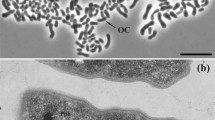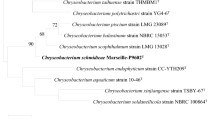Abstract
We have identified three Microbacterium strains, A18JL200T, NY27T, and WY121T, that produce C50 carotenoids. Taxonomy shows they represent three novel species. These strains shared < 98.5% 16S rRNA gene sequence identity with each other and were closely related to Microbacterium aquimaris JCM 15625T, Microbacterium yannicii JCM 18959T, Microbacterium ureisolvens CFH S00084T, and Microbacterium hibisci CCTCC AB 2016180T. Digital DNA-DNA hybridization (dDDH) values and average nucleotide identity (ANI) showed differences among the three strains and from their closest relatives, with values ranging from 20.4% to 34.6% and 75.5% to 87.6%, respectively. These values are below the threshold for species discrimination. Both morphology and physiology also differed from those of phylogenetically related Microbacterium species, supporting that they are indeed novel species. These strains produce C50 carotenoids (mainly decaprenoxanthin). Among the three novel species, A18JL200T had the highest total yield in carotenoids (6.1 mg/L or 1.2 mg/g dry cell weight). Unusual dual isoprenoid biosynthetic pathways (methylerythritol phosphate and mevalonate pathways) were annotated for strain A18JL200T. In summary, we found strains of the genus Microbacterium that are potential producers of C50 carotenoids, but their genome has to be investigated further.
Similar content being viewed by others
References
Asker, D., Awad, T.S., Beppu, T., and Ueda, K. 2018. Rapid and selective screening method for isolation and identification of carotenoid-producing bacteria. In Barreiro, C. and Barredo, J.L. (eds.), Microbial Carotenoids: Methods and Protocols. vol. 1852, pp. 143–170. Humana Press, New York, USA.
Ausich, R.L. 1997. Commercial opportunities for carotenoid production by biotechnology. Pure Appl. Chem.69, 2169–2174.
Aziz, R.K., Bartels, D., Best, A.A., DeJongh, M., Disz, T., Edwards, R.A., Formsma, K., Gerdes, S., Glass, E.M., Kubal, M., et al. 2008. The RAST Server: rapid annotations using subsystems technology. BMC Genomics9, 75.
Blin, K., Shaw, S., Steinke, K., Villebro, R., Ziemert, N., Lee, S.Y., Medema, M.H., and Weber, T. 2019. antiSMASH 5.0: updates to the secondary metabolite genome mining pipeline. Nucleic Acids Res.47, W81–W87.
Cerny, G. 1978. Studies on the aminopeptidase test for the distinction of Gram-negative from Gram-positive bacteria. European J. Appl. Microbiol. Biotechnol.5, 113–122.
Cheng, L., Ming, H., Zhao, Z.L., Ji, W.L., Zhang, L.Y., Li, L., Meng, X., Li, M., Niu, M., and Nie, G.X. 2019. Microbacterium ureisolvens sp. nov., isolated from a Yellow River sample. Int. J. Syst. Evol. Microbiol.69, 560–566.
Choi, H.S., Lee, S.Y., Kim, T.Y., and Woo, H.M. 2010. In silico identification of gene amplification targets for improvement of lycopene production. Appl. Environ. Microbiol.76, 3097–3105.
Corretto, E., Antonielli, L., Sessitsch, A., Höfer, C., Puschenreiter, M., Widhalm, S., Swarnalakshmi, K., and Brader, G. 2020. Comparative genomics of Microbacterium species to reveal diversity, potential for secondary metabolites and heavy metal resistance. Front. Microbiol.11, 1869.
Courington, D.P. and Goodwin, T.W. 1955. A survey of the pigments of a number of chromogenic marine bacteria, with special reference to the carotenoids. J. Bacteriol.70, 568–571.
Daum, M., Herrmann, S., Wilkinson, B., and Bechthold, A. 2009. Genes and enzymes involved in bacterial isoprenoid biosynthesis. Curr. Opin. Chem. Biol.13, 180–188.
Felsenstein, J. 1981. Evolutionary trees from DNA sequences: a maximum likelihood approach. J. Mol. Evol.17, 368–376.
Fitch, W.M. 1971. Toward defining the course of evolution: minimum change for a specific tree topology. Syst. Zool.20, 406–416.
Giuffrida, D., Sutthiwong, N., Dugo, P., Donato, P., Cacciola, F., Girard-Valenciennes, E., Le Mao, Y., Monnet, C., Fouillaud, M., Caro, Y., et al. 2016. Characterisation of the C50 carotenoids produced by strains of the cheese-ripening bacterium Arthrobacter arilaitensis. Int. Dairy J.55, 10–16.
Gogichaeva, N.V. and Alterman, M.A. 2012. Amino acid analysis by means of MALDI TOF Mass Spectrometry or MALDI TOF/TOF tandem mass spectrometry. In Alterman, M.A. and Hunziker, P. (eds.), Amino Acid Analysis: Methods and Protocols. vol. 828, pp. 121–135. Humana Press, Totowa, New Jersey, USA.
Goksøyr, A. 2013. Carotenoid sunscreen. US20130078203 A1, USA.
He, C., Fan, Y., Liu, G., and Zhang, H. 2008. Isolation and identification of a strain of Aspergillus tubingensis with deoxynivalenol biotransformation capability. Int. J. Mol. Sci.9, 2366–2375.
Jin, L., Zhao, Y., Song, W., Duan, L., Jiang, S., Wang, X., Zhao, J., and Xiang, W. 2019. Streptomyces inhibens sp. nov., a novel actinomycete isolated from rhizosphere soil of wheat (Triticum aestivum L.). Int. J. Syst. Evol. Microbiol.69, 688–695.
Karojet, S., Kunz, S., and van Dongen, J.T. 2012. Microbacterium yannicii sp. nov., isolated from Arabidopsis thaliana roots. Int. J. Syst. Evol. Microbiol.62, 822–826.
Kim, H., Choo, Y.J., Song, J., Lee, J.S., Lee, K.C., and Cho, J.C. 2007. Marinobacterium litorale sp. nov. in the order Oceanospirillales. Int. J. Syst. Evol. Microbiol.57, 1659–1662.
Kim, K.K., Lee, K.C., Oh, H.M., and Lee, J.S. 2008. Microbacterium aquimaris sp. nov., isolated from seawater. Int. J. Syst. Evol. Microbiol.58, 1616–1620.
Krubasik, P., Kobayashi, M., and Sandmann, G. 2001a. Expression and functional analysis of a gene cluster involved in the synthesis of decaprenoxanthin reveals the mechanisms for C50 carotenoid formation. Eur. J. Biochem.268, 3702–3708.
Krubasik, P., Takaichi, S., Maoka, T., Kobayashi, M., Masamoto, K., and Sandmann, G. 2001b. Detailed biosynthetic pathway to decaprenoxanthin diglucoside in Corynebacterium glutamicum and identification of novel intermediates. Arch. Microbiol.176, 217–223.
Kumar, S., Stecher, G., Li, M., Knyaz, C., and Tamura, K. 2018. MEGA X: molecular evolutionary genetics analysis across computing platforms. Mol. Biol. Evol.35, 1547–1549.
Lange, B.M., Rujan, T., Martin, W., and Croteau, R. 2000. Isoprenoid biosynthesis: the evolution of two ancient and distinct pathways across genomes. Proc. Natl. Acad. Sci.97, 13172–13177.
Lee, I., Kim, Y.O., Park, S.C., and Chun, J. 2016. OrthoANI: an improved algorithm and software for calculating average nucleotide identity. Int. J. Syst. Evol. Microbiol.66, 1100–1103.
Leifson, E. 1960. Atlas of bacterial flagellation. Academic Press, New York, USA.
Liu, N., Liu, B., Wang, G., Soong, Y.H.V., Tao, Y., Liu, W., and Xie, D. 2020. Lycopene production from glucose, fatty acid and waste cooking oil by metabolically engineered Escherichia coli. Biochem. Eng. J.155, 107488.
Ludwig, W. 2007. Nucleic acid techniques in bacterial systematics and identification. Int. J. Food Microbiol.120, 225–236.
Mata-Gómez, L.C., Montañez, J.C., Méndez-Zavala, A., and Aguilar, C.N. 2014. Biotechnological production of carotenoids by yeasts: an overview. Microb. Cell Fact.13, 12.
Meddeb-Mouelhi, F., Moisan, J.K., Bergeron, J., Daoust, B., and Beauregard, M. 2016. Structural characterization of a novel antioxidant pigment produced by a photochromogenic Microbacterium oxydans strain. Appl. Biochem. Biotechnol.180, 1286–1300.
Meier-Kolthoff, J.P., Auch, A.F., Klenk, H.P., and Göker, M. 2013. Genome sequence-based species delimitation with confidence intervals and improved distance functions. BMC Bioinformatics14, 60.
Minnikin, D.E., Patel, P.V., Alshamaony, L., and Goodfellow, M. 1977. Polar lipid composition in the classification of Nocardia and related bacteria. Int. J. Syst. Evol. Microbiol.27, 104–117.
Montero-Lobato, Z., Ramos-Merchante, A., Fuentes, J.L., Sayago, A., Fernández-Recamales, Á., Martínez-Espinosa, R.M., Vega, J.M., Vílchez, C., and Garbayo, I. 2018. Optimization of growth and carotenoid production by Haloferax mediterranei using response surface methodology. Mar. Drugs16, 372.
Na, S.I., Kim, Y.O., Yoon, S.H., Ha, S.M., Baek, I., and Chun, J. 2018. UBCG: up-to-date bacterial core gene set and pipeline for phylogenomic tree reconstruction. J. Microbiol.56, 280–285.
Netzer, R., Stafsnes, M.H., Andreassen, T., Goksøyr, A., Bruheim, P., and Brautaset, T. 2010. Biosynthetic pathway for γ-cyclic Sarcinaxanthin in Micrococcus luteus heterologous expression and evidence for diverse and multiple catalytic functions of C50 carotenoid cyclases. J. Bacteriol.192, 5688–5699.
Niu, S., Zhou, T.T., Xie, C.L., Zhang, G.Y., and Yang, X.W. 2017. Microindolinone A, a novel 4,5,6,7-tetrahydroindole, from the deep-sea-derived actinomycete Microbacterium sp. MCCC 1A11207. Mar. Drugs15, 230.
Osawa, A., Ishii, Y., Sasamura, N., Morita, M., Kasai, H., Maoka, T., and Shindo, K. 2010. Characterization and antioxidative activities of rare C50 carotenoids sarcinaxanthin, sarcinaxanthin monoglucoside, and sarcinaxanthin diglucoside-obtained from Micrococcus yunnanensis. J. Oleo Sci.59, 653–659.
Park, S.Y., Binkley, R.M., Kim, W.J., Lee, M.H., and Lee, S.Y. 2018. Metabolic engineering of Escherichia coli for high-level astaxanthin production with high productivity. Metab. Eng.49, 105–115.
Saitou, N. and Nei, M. 1987. The neighbor-joining method: a new method for reconstructing phylogenetic trees. Mol. Biol. Evol.4, 406–425.
Sasidharan, P., Raja, R., Karthik, C., Ranandkumar, S., and Indra Arulselvi, P. 2013. Isolation and characterization of yellow pigment producing Exiguobacterium sps. J. Biochem. Tech.4, 632–635.
Sasser, M. 1990. Identification of bacteria by gas chromatography of cellular fatty acids. MIDI Technical Note 101. MIDI Inc., Newark, Delaware, USA.
Savi, D.C., Shaaban, K.A., Gos, F.M.W., Thorson, J.S., Glienke, C., and Rohr, J. 2019. Secondary metabolites produced by Microbacterium sp. LGMB471 with antifungal activity against the phytopathogen Phyllosticta citricarpa. Folia Microbiol.64, 453–460.
Schippers, A., Bosecker, K., Spröer, C., and Schumann, P. 2005. Microbacterium oleivorans sp. nov. and Microbacterium hydrocarbonoxydans sp. nov., novel crude-oil-degrading Gram-positive bacteria. Int. J. Syst. Evol. Microbiol.55, 655–660.
Schleifer, K.H. and Kandler, O. 1972. Peptidoglycan types of bacterial cell walls and their taxonomic implications. Bacteriol. Rev.36, 407–477.
Schrader, J. and Bohlmann, J. 2015. Biotechnology of isoprenoids. Springer, Cham, Switzerland.
Schumann, P. 2011. 5 — Peptidoglycan Structure. In Rainey, F. and Oren, A. (eds.), Methods in Microbiology, vol. 38, pp. 101–129. Academic Press, London, United Kingdom.
Seto, H., Watanabe, H., and Furihata, K. 1996. Simultaneous operation of the mevalonate and non-mevalonate pathways in the biosynthesis of isopentenly diphosphate in Streptomyces aeriouvifer. Tetrahedron Lett.37, 7979–7982.
Takeuchi, M. and Hatano, K. 1998. Union of the genera Microbacterium Orla-Jensen and Aureobacterium Collins et al. in a redefined genus Microbacterium. Int. J. Syst. Evol. Microbiol.48, 739–747.
Taniguchi, H., Henke, N.A., Heider, S.A.E., and Wendisch, V.F. 2017. Overexpression of the primary sigma factor gene sigA improved carotenoid production by Corynebacterium glutamicum application to production of β-carotene and the non-native linear C50 carotenoid bisanhydrobacterioruberin. Metab. Eng. Commun.4, 1–11.
van Belkum, A. and Hermans, P.W. 2001. BOX PCR fingerprinting for molecular typing of Streptococcus pneumoniae. In Gillespie S.H. (ed.), Antibiotic Resistence. Methods in Molecular Medicine, vol. 48, pp. 159–168. Humana Press. Totowa, New Jersey, USA.
van der Weele, C.M., Spollen, W.G., Sharp, R.E., and Baskin, T.I. 2000. Growth of Arabidopsis thaliana seedlings under water deficit studied by control of water potential in nutrient-agar media. J. Exp. Bot.51, 1555–1562.
Venil, C.K., Zakaria, Z.A., and Ahmad, W.A. 2013. Bacterial pigments and their applications. Process Biochem.48, 1065–1079.
Vila, E., Hornero-Méndez, D., Azziz, G., Lareo, C., and Saravia, V. 2019. Carotenoids from heterotrophic bacteria isolated from Fildes Peninsula, King George Island, Antarctica. Biotechnol. Rep.21, e00306.
Xie, F., Pei, S., Lin, X., Tian, Y., and Zhang, G. 2021. A rapid and efficient method for the extraction and identification of menaquinones from Actinomycetes in wet biomass. BMC Microbiol.21, 175.
Yan, Z.F., Lin, P., Won, K.H., Yang, J.E., Li, C.T., Kook, M.C., Wang, Q.J., and Yi, T.H. 2017. Microbacterium hibisci sp. nov., isolated from rhizosphere of mugunghwa (Hibiscus syriacus L.). Int. J. Syst. Evol. Microbiol.67, 3564–3569.
Yang, J. and Guo, L. 2014. Biosynthesis of β-carotene in engineered E. coli using the MEP and MVA pathways. Microb. Cell Fact.13, 160.
Yoon, S.H., Ha, S.M., Kwon, S., Lim, J., Kim, Y., Seo, H., and Chun, J. 2017. Introducing EzBioCloud: a taxonomically united database of 16S rRNA gene sequences and whole-genome assemblies. Int. J. Syst. Evol. Microbiol.67, 1613–1617.
Acknowledgements
This work was supported by China Ocean Mineral Resources R&D Association (COMRA) Program (No. DY135-B2-01) and the Scientific Research Foundation of Third Institute of Oceanography, MNR (No. 2019011).
All authors have contributed to the creation of this manuscript for important intellectual content and read and approved the final manuscript.
Author information
Authors and Affiliations
Corresponding author
Ethics declarations
We declare there is no conflict of interest.
Additional information
Supplemental material for this article may be found at http://www.springerlink.com/content/120956.
Electronic supplementary material
Rights and permissions
About this article
Cite this article
Xie, F., Niu, S., Lin, X. et al. Description of Microbacterium luteum sp. nov., Microbacterium cremeum sp. nov., and Microbacterium atlanticum sp. nov., three novel C50 carotenoid producing bacteria. J Microbiol. 59, 886–897 (2021). https://doi.org/10.1007/s12275-021-1186-5
Received:
Revised:
Accepted:
Published:
Issue Date:
DOI: https://doi.org/10.1007/s12275-021-1186-5




